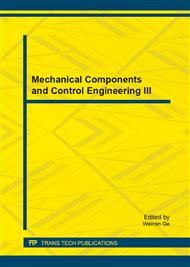p.230
p.236
p.240
p.244
p.248
p.253
p.258
p.264
p.268
Simulation and Analysis for Composite Casing Aging Trend Based on ANSYS
Abstract:
According to the aging characteristics of composite casing, we have established the composite bushing model of different radius with the ANSYS finite element analysis software, and analyzed the defects in different forms and the action under different mechanical stress. At the same time, we have studied the aging trend of composite casing and compared with the similarities and differences between the aging of composite insulators. The result showed that under the mechanical stress the bigger than the smaller aging deformation was more serious, and the defect forms had no obvious influence on the development of aging. Thus, the composite casing artificial accelerated aging test should increase the role of mechanical force factor, while the composite insulator aging research methods and conclusions should also increase the qualification when applied to silicone rubber composite casing.
Info:
Periodical:
Pages:
248-252
Citation:
Online since:
October 2014
Authors:
Keywords:
Price:
Сopyright:
© 2014 Trans Tech Publications Ltd. All Rights Reserved
Share:
Citation:


